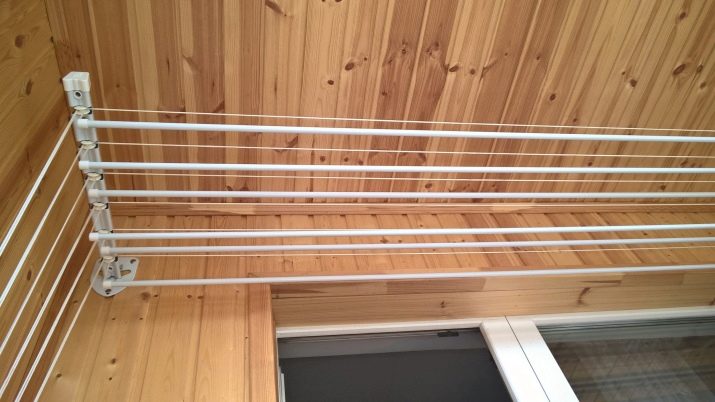Ceiling clothes dryers on the balcony: varieties, selection, installation
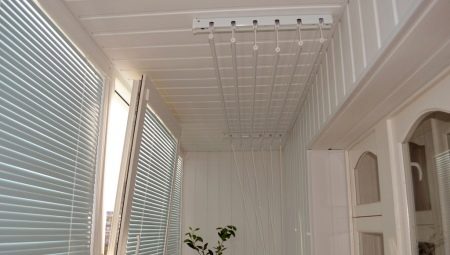
In a city apartment, you can't do without a clothes dryer. Although many people prefer the usual folding and mobile design, the lack of free space in the rooms and the presence of a balcony make it much more correct to purchase a ceiling model.
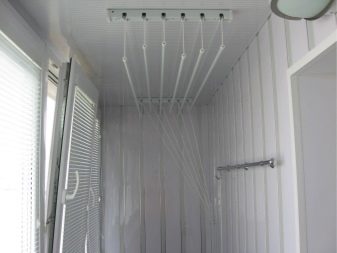
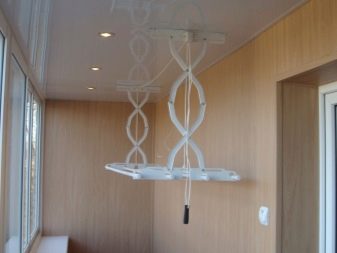
Advantages and disadvantages
A ceiling mounted clothes dryer on a balcony has several advantages and several disadvantages. The main advantages are considered to be its low cost, ranging from 600 to 1000 rubles, as well as the small size of the structure, allowing it to fit even in a confined space. In addition, the structure is completely safe, since it is almost impossible to hit the system located above it hard.
Ceiling models do not interfere with movement on the balcony, and also do not take up space on the floor. It is very easy to hang clothes, and the process does not even require the additional use of a ladder or chair.
Some models allow you to combine individual rungs using plastic parts, which means hanging out massive things, for example, blankets.
The installation process of the dryer is quite simple and does not take much time. It is fixed regardless of the material of the existing surface, be it wood or concrete.
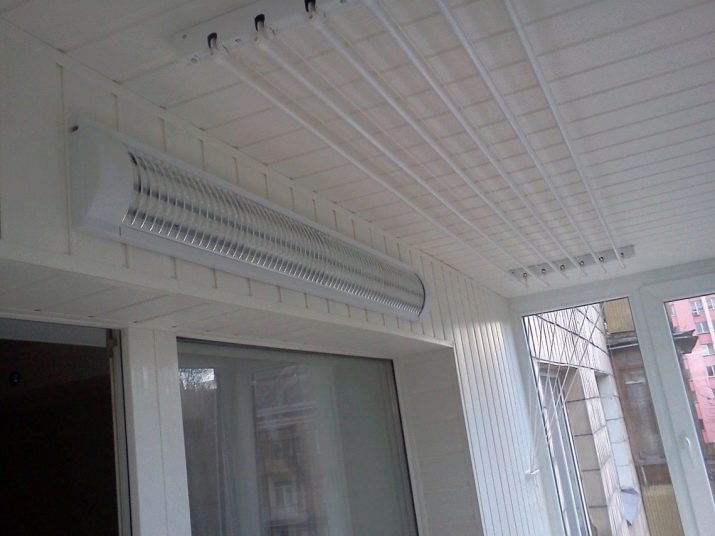
The main disadvantage of the clothes drying system is the ability to place an average of no more than 6 kilograms of damp laundry at a time, although, of course, this indicator depends on the chosen model. For some people, it is also not very convenient to hang small-format items on fairly wide bars.
Placing items that are too heavy on the dryer can cause the slats to bend. However, in most cases, this deficiency is eliminated with his own hand. One can also call a disadvantage the fact that under the condition of insufficient spinning, trickles of water flow down directly to the floor, and you have to substitute the basins or put rags.
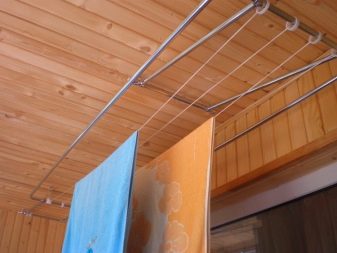
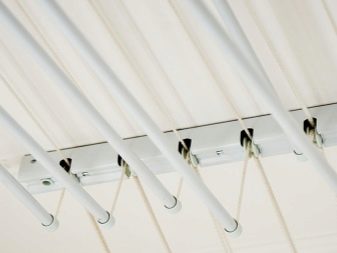
Views
There are several options for the suspended structure, which have one main similarity - their mechanism is fixed to the ceiling. However, the devices themselves can vary greatly, ranging from a simple frame to a complex electrical system. The simplest device looks like a frame made of metal or plastic. Usually, cords or metal chains are attached to the corners of the structure, connecting to a pyramid, the top of which is decorated with a hook. The ceiling dryer is thus fixed either on a metal ring mounted in the ceiling, or even on a strong, stretched clothesline.
Quite often, such dryers are sold equipped with clothespins, which greatly simplifies the process of using the structure. Since such structures do not differ in particular strength or size, they are used to dry children's clothes and small items, for example, socks, linen or handkerchiefs. The advantage of this design is that all the small things are dried in one place, without taking up the floor space. However, the low strength precludes the use of drying for heavier items.
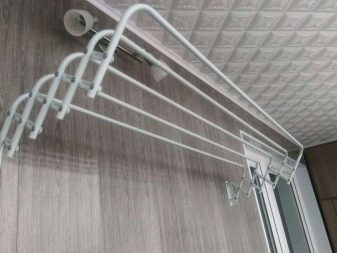
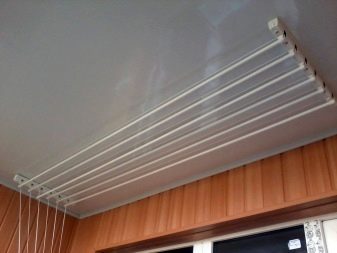
Such dryers have a subspecies used for those items of clothing that are not recommended to be hung on the crossbars and secured with clothespins. In this case, we are talking, for example, about woolen wardrobe or delicate fabrics. The design has a special polymer mesh stretched along the frame, on which the linen is laid out. Due to the perforation, the clothes are dried due to the flow of rising air. By the way, there may be more than one frame - multilevel systems are popular. They are compact, mobile and easy to store.
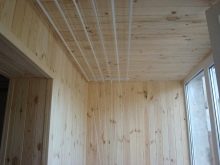
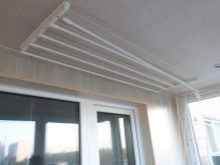
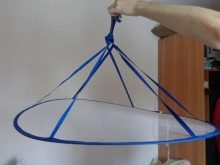
Drop-down dryers with an elevator mechanism, when not in use, are located almost at the ceiling, but if necessary, they can be easily pulled down. The structure is assembled from two parallel traverses, between which several crossbars are mounted. On the ceiling, these dryers are usually fastened with laces hanging from the ceiling blocks, which, in turn, are connected to traverses. The lift dryer is manually operated, although large structures with extended beams can also be operated with manual gearboxes. The lift system is easy to use and reliable, but requires an even distribution of wet laundry to avoid skewing.
Dryers of this type are sometimes movable. More complex construction costs a lot of money, but does not require an even distribution of wet clothing.
The elevator system can function due to the presence of a chain that connects to the gear wheel of the reducer. It should be mentioned that a similar ceiling dryer can be made with your own hands, even from wood, since it is not too complicated in execution.
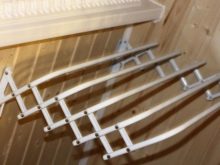
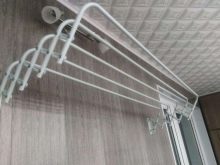
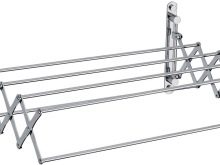
Liana dryers have more functionality than traverse-type structures, since there is no need to lift a heavy system, and the outer rows of clothing do not obstruct the inner ones. "Liana" consists of several bars, but each is individual and works without reference to the rest. Therefore, it will be possible to raise and lower any crossbar independently of the others, which means that it will always be possible to place all the washed laundry in a cascade. The construction turns out to be quite powerful and allows you to place a large amount of heavy wet clothes. When folded, the dryer "goes" almost to the ceiling and does not take up extra space.
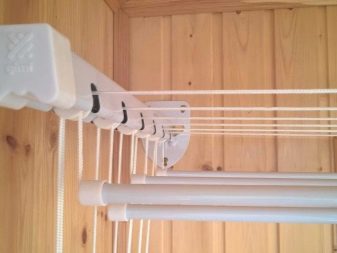
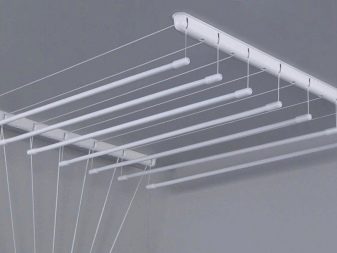
Electric tumble dryers are equipped with a special mechanism that allows them to be controlled remotely. Modern models function both at -40 degrees and at +50, which means they can be installed even on balconies without full thermal insulation and heating. Most often, the drying is equipped with fluorescent light bulbs or LEDs, which additionally solves the issue of lighting the loggia. To activate the dryer, you will have to use either the control panel or the block located here on the wall. This allows the dryer to be raised and lowered, as well as to turn on the lighting. The highest quality models can withstand up to 30 kilograms.
In addition, electric hanging structures can also directly dry the laundry. This happens either with the help of rods heated to almost 50 degrees, or with heated air directed in the correct way.
In some cases, clothes are hung on hangers, which are just inside the dryer, and therefore it is not necessary to iron them further. However, for the functioning of this system, an outlet or an extension cord and at least 1 kW of energy per hour will be required, as well as compliance with fire safety rules. High prices, up to 30 thousand rubles, can scare off buyers.
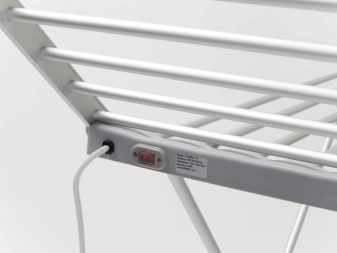
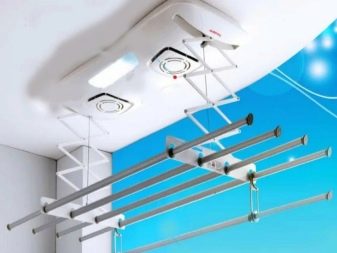
In general, all available designs can be divided into several groups, depending on the available mechanism. Retractable models are made of two parts, one of which is equipped with a drum with a rope. This detail is fixed on one of the walls of the balcony. With a simple movement, the structure is straightened, and the necessary parts are fixed on special nodes. After drying, the structure has to be folded back, which is not particularly difficult.
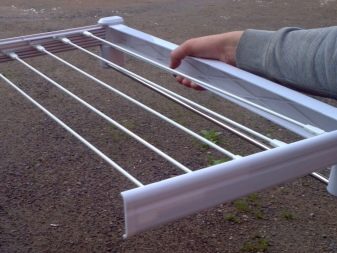
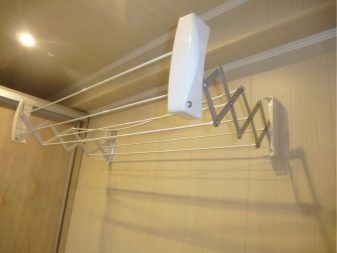
Telescopic dryers work by pushing out the supporting parts from each other. When folded, the system takes up space on the wall and does not interfere with movement around the balcony. Descending dryers include liana-type designs. Several planks are fixed to the ceiling, and the system is regulated by ropes and a retainer installed on one of the walls. Sliding dryers function thanks to accordion-folding links. Made of metal, such structures can be of any size.

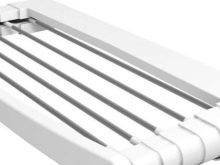
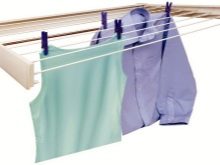
Dimensions (edit)
The dimensions of ceiling dryers depend mainly on the length of the ropes or bars used, on which the washed laundry is placed. Moreover, we are talking here about the total useful length, which most often ranges from 5 meters to 14.4 meters. This amount can be distributed over a different number of beams, which are most suitable for a particular balcony.
The length of one crossbar, as a rule, ranges from 1.5 to 2 meters and is calculated depending on the material of the dryer, as well as on the type of construction.
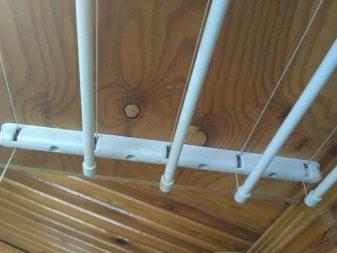
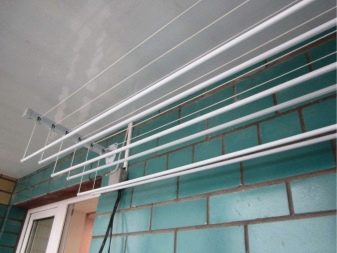
Materials (edit)
The ceiling dryer for the balcony can be made of different materials. Stainless steel structures are considered the most reliable, but also expensive. The material can be used to implement a variety of models, and it will certainly serve for many years. Painted or polymer coated steel has a slightly lower quality. In this case, a polymer coating is preferable, since the coloring material wears off over time.
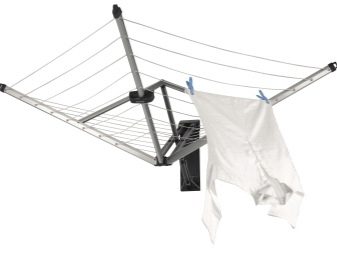
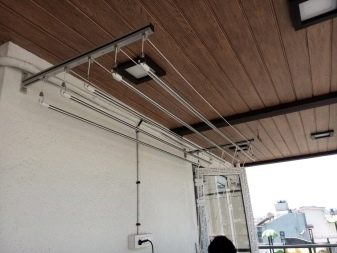
A metal dryer made of aluminum also performs well, but quite often contributes to the appearance of stains on clothes, which are the result of oxidative processes on surfaces. Plastic structures are the least preferred in terms of reliability, strength and durability. However, the appearance of these structures can be extremely attractive. When choosing materials for a drying structure, it is important to avoid chrome steel... As a rule, the coating quickly crumbles and flies around, after which rust appears.

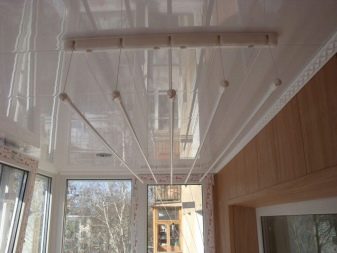
The combination of materials is considered quite successful, when the supporting parts are made of steel with a powder coating, and the crossbeams themselves are made of plastic. Such models turn out to be quite budgetary, but durable. With a homemade version, of course, the list of materials used becomes more extensive. For example, to strengthen the structure, an iron part is often used, for example, corners, and an ordinary rope takes up plastic crossbars.
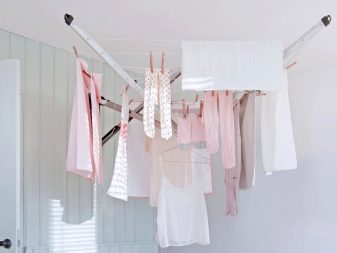
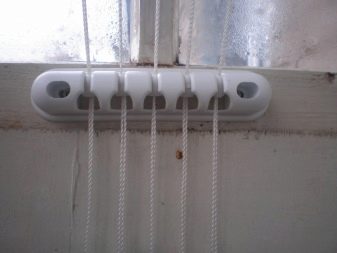
Manufacturers overview
Although it is generally accepted that the best products come from European countries, in the matter of ceiling dryers for balconies, quality models quite often come from China. For example, we are talking about Alcona ASB-602, which is a dryer with automated lifting and lowering functions. The design has four crossbars from 1250 to 2050 millimeters long. In addition to remote control, this model is equipped with additional lighting. The high-quality system can withstand 35 kilograms and operates at temperatures ranging from -25 degrees to +40 degrees.
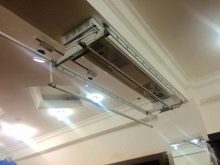
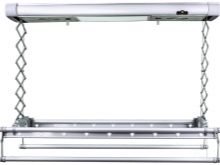
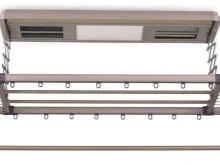
If you need a dryer for wool or delicate linen, then it makes sense to purchase a model Niklen created in Canada. The construction has two levels and is made of polyester. The dimensions of this lightweight system are not so large - only 600 x 700 millimeters.
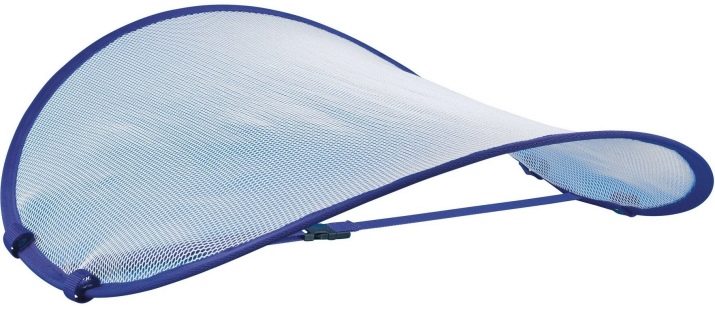
Italian dryers are also popular, for example, Gimi Lift 180... The "liana" type construction consists of 6 crossbars made of steel with a polymer coating. The "liana" withstands only 15 kilograms, occupying 1800 millimeters in length and 430 millimeters in width.
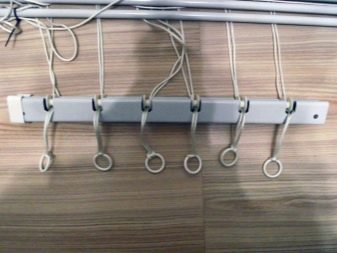

Multifunctional dryer SensPa Marmi made in South Korea. The automatic system has a hairdryer, a timer and a pair of LED lights. In addition, a remote control is also available. The length of the structure is 1030 millimeters, and the width is only 431 millimeters.
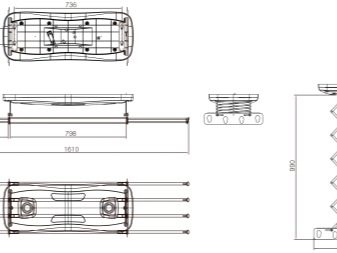

In general, experts recommend giving preference to brands Leifheit from Germany, Italian Gimi and Meliconi, SNB from Poland and Dogrular from Turkey. Chinese brands are usually marketed under the names Natalie or Delta.
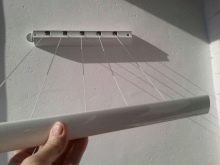
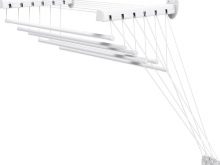
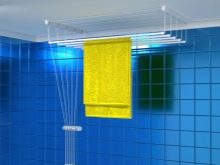
How to choose?
In order to choose the right balcony hanger for laundry, several important characteristics must be considered. In many ways, the selection of a model for the ceiling of the loggia is determined depending on how much bed linen is to be dried at a time. Usually this parameter is related to the total length of the members. The latter is either immediately indicated in the instructions, or it is calculated by multiplying the number of rods by their length. The higher the figure is, the more clothes can be dried, but also the more free space you will need to take.
The linen structure must be made of quality materials in accordance with technology. If the plastic is covered with color stains, or the metal parts have burrs or an incomprehensible shape, then this immediately indicates the low quality, as well as the fragility of the dryer service. Of course, the absence of any cracks and chips is also important. Since the beams are made of either metal or plastic, their choice should be made depending on the conditions of use, that is, temperature. It is better to choose metal parts, but not those that have a plastic coating, or are simply covered with enamel.... In addition, after each use of the dryer, it is recommended to wipe it down with a dry and soft cloth.
Since the dimensions of the ceiling drying are very variable, you have to decide in advance how much of the space you can take for the structure. It is necessary to determine the dimensions of the system when folded, since it should not interfere with opening and closing windows, a balcony door and simply moving along the loggia.
In addition, it is important that the hanging linen does not obscure the passage. It is necessary to think over the entire installation process, that is, the material of the ceiling covering, especially in the case of a suspended or tensioned version.
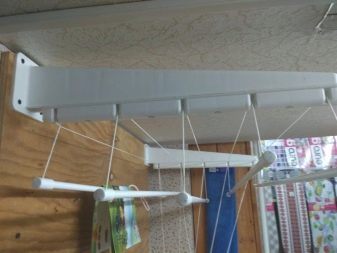
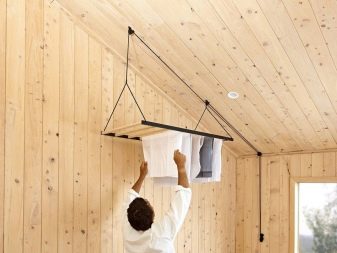
How to install?
Most often, the installation of a ceiling dryer is carried out by the owners of the apartment themselves, since it is not particularly difficult to fix the system. Installation instructions are usually included with the purchase and contain all the necessary information. Before you hang the dryer and even decide on the mount, it is necessary to properly prepare the surface of the ceiling. The existing coating is cleaned of dust and dirt, after which the marking is carried out. For this purpose, the bracket is applied to the surface across the load-bearing wall and the results are recorded with a pencil or washable marker.
The next mark is made through a gap equal to the length of the string, and also parallel to the first fastener. The brackets must be at least 10 centimeters apart from the wall. Holes are made at the indicated points with a drill, and the brackets are fixed using anchor bolts.
Further, as a rule, the tubes are inserted into the holes of the side strips of the structure and must be muffled. Bolts are required to secure the frame to the brackets.
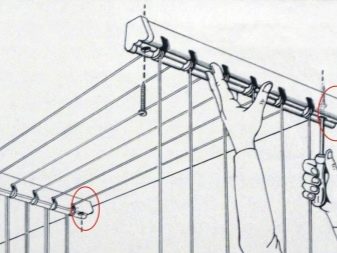
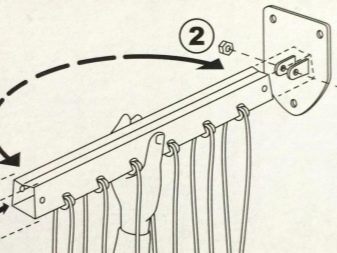
Installation according to a different algorithm begins with the fact that clotheslines are tucked into the rods in such a way that one long and one short cord is fixed on each bar. Further, roller hangers are mounted on the ceiling. If the ceiling is made of wood, then long screws are used, and if it is an ordinary concrete surface, then dowels or anchors will do. It is important that the number of fasteners is sufficient to withstand heavy, wet laundry. The distance between the individual fixings must be equal to the length of the dryer rails.
The clamps are mounted at the bottom of one of the walls in self-selected places. Next, the rods are installed, which are then attached to the retainer.
The structure is pulled up to the ceiling and fixed with a latch on the wall. After adjusting the dryer, it is also necessary to check the quality of the installation using evenly distributed wet laundry.
How to install a tumble dryer on a balcony, see below.
Review overview
In most cases, reviews of ceiling dryers for the balcony are positive. Users note that the design allows you to quickly, efficiently and evenly distribute the washed items. Most often, preference is given to models made of metal and high-quality plastic for crossbars, which does not dye clothing and does not leave creases on it. Since the design is quite compact, it does not interfere at all and does not occupy important square meters. All linen is located under the ceiling, and therefore the view is also not obstructed.
Electric models are especially popular, which are convenient to control and which often also work as balcony lamps. The wide price range allows you to purchase a dryer that suits any budget. The most preferred are dryers of the brand Gimi Lift is originally from Italy, or constructions of the "liana" type of Russian production. The first one is distinguished by ease of installation and high quality, but the "liana" construction costs half the price. In addition, the model of the Russian manufacturer has a pair of clips that allow you to fix the drying rope in different positions.
Returning to Gimi Lift, be sure to mention the thick and reliable ropes, the presence of six 12 mm rods, no need for assembly and the use of metal as the main material of manufacture.
Both products have a long service life provided that the rules of use are followed.For example, it is extremely important not to "overexpose" the laundry on the dryer for longer than indicated in the manufacturer's instructions.
